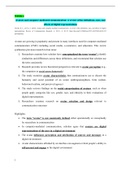WEEK 4
Avatars and computer-mediated communication: A review of the definitions, uses, and
effects of digital representations
Nowak, K. L., & Fox, J. (2018). Avatars and computer-mediated communication: A review of the definitions, uses, and effects of digital
representations. Review of Communication Research, 6, 30-53., 6, 30–53. https://doi.org/10.12840/issn.2255-4165.2018.06.01.015
[INTERNET]
Avatars are growing in popularity and present in many interfaces used for computer-mediated
communication (CMC) including social media, e-commerce, and education. This review
synthesizes previous research in four areas:
1. Researchers examine how scholars have conceptualized the term “avatar”, identify
similarities and differences across these definitions, and recommend that scholars use
the term consistently
2. Research provides review theoretical perspectives relevant to avatar perception (e.g.,
the computers as social actors framework)
3. The study examines avatar characteristics that communicators use to discern the
humanity and social potential of an avatar (anthropomorphism, form realism,
behavioral realism, and perceived agency)
4. The study reviews findings on the social categorization of avatars, such as when
people apply categories like sex, gender, race, and ethnicity to their evaluations of
digital representations
5. Researchers examine research on avatar selection and design relevant to
communication outcomes
Highlights:
* The term “avatar” is not consistently defined either operationally or conceptually
by researchers in communication
* In computer-mediated communication, scholars agree that avatars are digital
representations of the user in a digital environment
* The avatar influences perception and attribution of sources and messages in a
digital environment
* Avatar characteristics afforded by an interface can augment or limit people’s ability to
self-present and engage in the digital environment
1
, * Scholars can use avatars in research to facilitate experimental control and the
investigation of complex communication processes and theories.
Definition
The present article gauges existing research on avatars and puts together the following broad
definition of the concept: an avatar is a digital representation of a human user that
facilitates interaction with other users, entities, or the environment.
Across the literature, scholars have focused on three overlapping aspects that influence
users’ perceptions of the social potential of avatars:
1. Agency – whether or not an entity is perceived to be human
2. Anthropomorphism – having human form or behavior
3. Realism – having accurate form or behavior
Effects of avatar embodiment
The flexibility of avatars in many contexts means that a user’s self-representation can be
modified in meaningful ways that may be dissimilar to the physical self. According to the
Proteus effect, the user’s behavior conforms to the modified self-representation regardless of
the true physical self. The characteristics of an avatar may influence how a user
communicates both online and offline
When participants embody attractive avatars in a virtual environment, they disclose
more personal information and approach their partner’s avatar more closely
When participants embody taller avatars, they are more confident and aggressive when
negotiating with another person
Ethical considerations
Given that the effect of embodying different avatars one time in a lab can influence off-
line behaviors and attitudes days or weeks later, researchers and designers must carefully
consider how these experiences may influence others long term. Although there may be
prosocial effects of embodying avatars depicting races, or identities different from our
corporeal bodies, researchers, designers, and users must be careful to avoid antisocial
effects such as the reinforcement of stereotypes and the entrenchment of bias.
Conclusions
2
, In conclusion, existing research on avatars has not only allowed us to understand more about
how people use, perceive, and are affected by avatars, but it has also illuminated
communication processes more broadly. Going forward, there is no shortage of ways in
which avatar research can lend further insight into human communication, but researchers
must carefully consider the ethical implications of research designs and the potential for long-
term effects of avatar interactions.
Social effects of virtual and robot companions
Krämer, N. C., Rosenthal-von der Pütten, A. M., & Hoffmann, L. (2015). Social effects of virtual and robot companions. In S. S. Sundar
(Ed.), The handbook of the psychology of communication technology (pp. 137–159). Chichester, UK: Wiley-Blackwell. [After clicking on
the book title, use under “Full text availability” the option “Wiley Online Library Online Books”]
The effects of embodied interface agents can be termed “social” if a participant’s
emotional, cognitive, or behavioral reactions are similar to reactions shown during
interactions with other human beings (Krämer, 2005). The studies that have been
conducted in the research realm not only show that these reactions really do occur, but they
also provide evidence that the reactions are largely unconscious and that the social cues
which elicit the effects can be rather subtle.
The most important contribution to theory development provided by this research is the
conclusion that can be derived concerning explanations for social effects
* In the conditions of high behavioral realism, participants experienced more feelings of
mutual awareness, and they used more words during the interaction – the assumed
agency, on the other hand, did not have an influence
* The follow-up study by Appel et al. (2012) additionally showed that not only
behavioral realism but also number of social cues plays a role
Therefore, in sum, this study showed that artificial entities are able to evoke similar
reactions to avatars (i.e., humans) and that these are stronger when more social cues
and behavioral realism are present.
With regard to the role of personality characteristics of the user, the most important
finding of the present study, is that especially those traits that relate to behavioral patterns in
social contact (e.g., agreeableness, extraversion, approach avoidance, self-monitoring
sensitivity, shy- ness, and public self-consciousness) were found to be predictive of the
3




